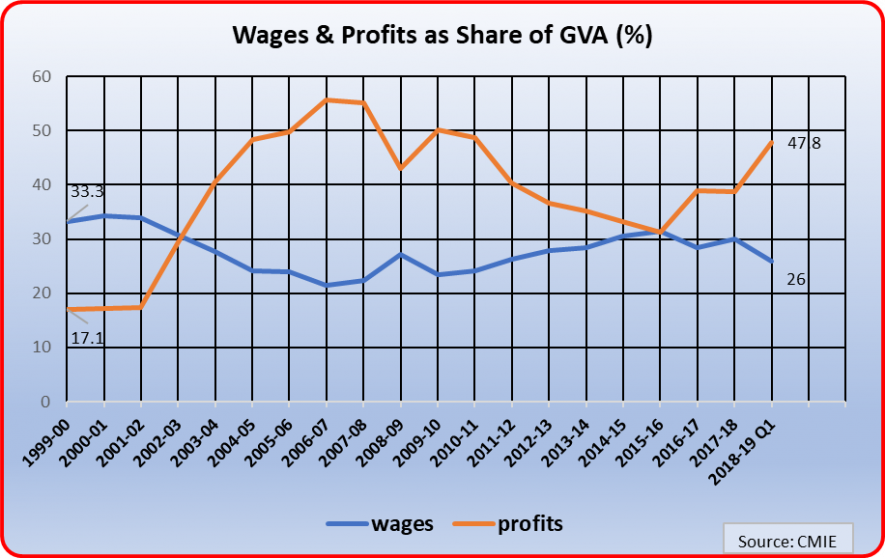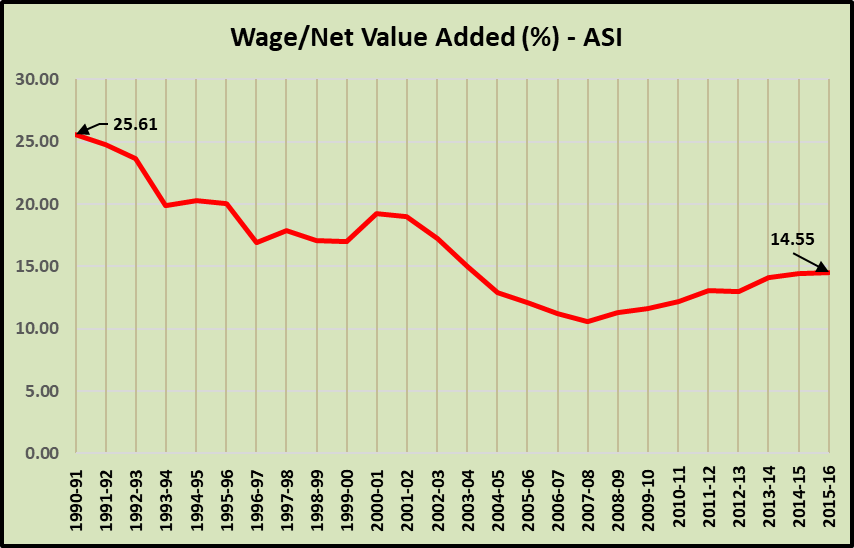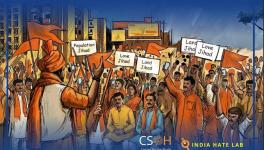Modi’s Rule Is Boosting Profits, Squeezing Wages

In a dramatic indictment of Modi government’s policies, a CMIE analysis of corporate financial reports indicates that profit share in gross value added (GVA) has increased from around 31% in 2015-16 to 47.8% in the first quarter of 2018-19 while the share of wages has dipped from 31.4% to 26% in the same period. Gross value added is the sum of wages, profits, interest paid, rent and depreciation. The figures are for listed manufacturing companies, that is, all the big corporate houses in the manufacturing sector traded in the stock exchange.
The imbalance represents an intensification of exploitation of labour on the back of which corporate profits are being made. This is possible only because of government policies that are brazenly favouring corporate businesses while diluting and destroying protection for workers.

As the graph shows, the relative shares of wages and profits have an inverse relationship – when one side rises, the other side dips. Back at the turn of the century, the respective shares were the other way round – wages made up 33.3% while profits were 17.1% of GVA in 1999-2000. Interestingly, the coming to power of the first Bharatiya Janata Party-led National Democratic Alliance government also saw the inversion take place. By 2003-04, corporate profit share was 40.5% and wage share was down to 27.7%. This trend of rising profit share continued unabated under the Congress-led United Progressive Alliance regime till about midway through UPA 2, barring a blip in 2008-09 caused by the international financial crisis.
Since 2009-10, but more decisively after 2010-11, corporate profits’ share started declining and wage share started rising as the Indian economy stumbled and faltered. Remember, these are shares of GVA not absolute amounts. That means, a decline in share of profits does not mean that profits were down. It only means that profit was less than before.
This slide was accompanied by a rise in wage share, so much so that by 2015-16, both were nearly the same at about 31.3%.
But the Modi effect became clear after that as profits share zoomed up and wage share declined steadily in the last three years.
These are numbers for the large corporates in manufacturing sector. CMIE (Centre for Monitoring Indian Economy) estimates that their profits shares are about 6.5 percentage points higher than smaller companies. But even then, the trend of dipping wage shares – and hence the economic condition of workers – is the same for smaller companies.
According to the Annual Survey of Industries (ASI) data put out by the government, wage share of net value added (NVA) has steadily declined from about 26% in 1990-91 to about 15% in 2015-16, the last year for which data is available. The ASI covers about 65,000 factories in its surveys and provides a deeper view of the economics of industry. Of course, the small-scale sector is excluded from this.

What all this clearly establishes is that the rise of neo-liberal policies in India in the beginning of 1990s has had a severely damaging impact on the industrial working class. Wages have stagnated, as has employment. This has been achieved by the bourgeoisie through contractorisation of work, dilution of labour laws, destruction of labour law enforcement machinery and crushing of workers’ organisations and protests. The agrarian crisis has helped by providing a steady flow of unemployed labour to take up industrial or service sector jobs, thus keeping wages low.
But don’t forget Modi’s own specialised contribution – something for which he is thought of as a darling by the corporate honchos. Under his rule, the gloves are off, government spending is being cut, labour laws are being made toothless and a wave of privatisation has handed over large assets to private corporate bodies, many of them his cronies like Adani or Ambani.
This will also explain why Modi’s rule has been marked by two countrywide industrial strikes, over a dozen sectoral strikes or agitations, and a series of protest marches and sit-ins at the Capital in New Delhi, including the recent mammoth protest march on September 5, in which farmers and workers joined hands.
Get the latest reports & analysis with people's perspective on Protests, movements & deep analytical videos, discussions of the current affairs in your Telegram app. Subscribe to NewsClick's Telegram channel & get Real-Time updates on stories, as they get published on our website.
























